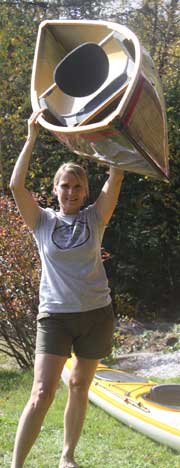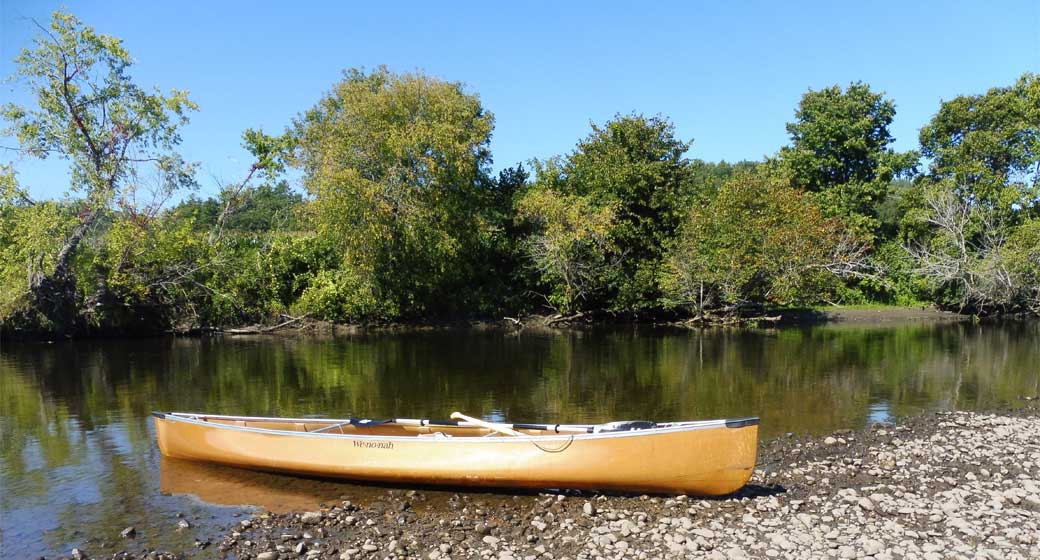




![]() Ultralight boats!
Ultralight boats!
How to go in a Straight Line
Making your canoe travel in a straight line can be an extremely frustrating task. Just ask the couple who are bouncing off both shorelines of a small lake like a pin ball as they attempt to get to a picnic spot _ mile away on the other side. Once you have mastered the technique though, it will happen without a second thought.
The first thing you need to do is decide where you are going, aim the boat in that direction and head for it. A well executed forward stroke will come in handy at this point. (If you have read my last article and practiced you should have this on under control) Make sure that you and your partner paddle on opposite sides of the canoe and stroke together. The bow paddler sets the pace and its up to the stern paddler to match it. It is also important to run your stroke parallel to the direction of travel and not follow the curve of the hull.


There is a natural tendency for the canoe to turn away from the stern paddler because of the increased leverage this position enjoys. If you have a good forward stroke you can limit this effect but eventually it will occur. As the canoe begins to turn away from you (the stern paddler), you will need to take some corrective action if the canoe is expected to continue on a straight course. Any corrective stroke creates drag which slows down the canoe, so you want to limit it as much as possible. A steady application of small corrections works much better then a single large one. Subtlety and finesse are the key words here.
For flat out speed and efficiency the best technique is for both paddlers to switch sides. The instant the stern paddler feels the canoe begin to slide off line he/she should give the command to switch sides. Repeat the process as needed. The number of strokes you will paddle per side will vary depending on a number of factors. A good range would be from 5 — 10 strokes. This style of paddling lends itself well to a quick pace and it does not cause any drag or loss of hull speed which is why it is seen used most often by racers.
A more traditional method is to use a "J" stroke or some variation of it. It is performed by the stern paddler literally carving a "J" in the water.
direction of travel ---> 
You begin just as you would with a forward stroke. When you get to your hip, (end of the power phase) feather the blade (turn it sideways) and carve the curve of the "J". This is done by pushing the paddle away from the canoe with your bottom hand and guiding it through the curve with the top hand by pulling down and back as needed. As you do this the boat will respond and turn back toward you. How far the boat needs to turn will dictate how hard and far you carry the stroke. The faster you are moving the more effect this stroke will have. Fool around and experiment with it. An effective way to practice is by yourself.
When you first start you will find it awkward and the full curve of the "J" will be needed to make the canoe perform. Once you have got it mastered though all that is required is a quick flip of the wrist every couple of strokes. At this point most people won't notice that you have done anything at all, except that you are traveling effortlessly in a straight line through the water. Try using the switching and a modified "J" together. It is a nice combination for easy cruising allowing you to stay on side for longer periods of time and still maintain a good pace.

Have a question? I'm happy to answer it - just email me at hpcanoes@gmail.com
![]()
hpcanoes@gmail.com
603.667.5112

We specialize in ultralight solutions and offer expertise in canoes and Wee Lassie boats, as well as all the related equipment. Our favorites are Wenonah canoes and Wee Lassie boats. Although we will work with any material we like to get folks set up with lightweight canoes so you can dedicate your time to the joy of being out on the lakes and rivers instead of struggling to move your boat between car and water.
Scott Edwards, "Hemlock Pete" himself, offers you decades of paddling expertise. He is friendly, down-to-earth, and provides superior customer service. You won't find a better, or more pleasant, deal elsewhere.

